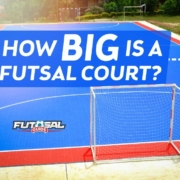Any parent who is considering getting their children involved in futsal will have a number of questions that they would want to clarify before making the final enrolment. I’ve ensured any parent who reads this post will walk away with informed about the safety of Futsal.
Is Futsal Safe For Kids?
Futsal has nowhere near the level of contact when compared to Gridiron, Rugby or Martial Arts. Also, Players cannot slide tackle in Futsal as compared to Soccer. Futsal is relatively safe and players should wear shin pads and mouth guards as well as long socks to reduce the possibility of injuries.
There are many things parents can do along with children when it comes to participating in Futsal to reduce the chance of injury and other related hiccups. By preparing for Futsal games to wearing the correct gear to ensure your child is as safe as possible. It’s important for both child and parent to be well informed.
Minimal Contact At All Times
Futsal does not allow for excessive contact such as shirt pulling, tackling, grappling or anything other then slightly jostling for the ball. You won’t have to worry about your child getting a concussion or getting knocked out as they are both relatively unlikely.
Under the Futsal Laws Of The Game the following are classified as fouls:
- Kicks or attempts to kick an opponent
- Trips an opponent
- Jumps at an opponent
- Charges an opponent
- Strikes or attempts to strike an opponent
- Pushes an opponent
- Tackles an opponent
- Holds an opponent
- Slide tackles are considered a foul and not permitted
Players are well protected from injury and parents can rest assured that their children shall be well protected not only by the Laws Of The Game but also by the Futsal referee.
Parents can often be faced with challenging decisions in regards to what junior sport to enrol their child in, when compared to a sport like Gridiron for example where an excess of protective equipment is required to protect the child from head and torso injuries then Futsal should be considered as a much safer alternative.
Children playing in the position of goalkeeper may find themselves more likely to come into contact with other players due to the inherent nature of the position.
As Goalkeepers in Futsal can face a number of shots and at a high velocity they face a risk of:
- Head injury, there is a higher chance goalkeepers can be hit in the head or face by a Futsal ball or a wayward leg/arm by an opposition player
- Finger injury, as goalkeepers will be stopping shots with their hands and fingers there is the possibility of hyper flexing fingers and damaging ligaments and possibly broken bones
- Collision injuries, goalkeepers may collide with opposition players when attempting to block shots and break down attacks
- Mouth injury, also a risk to out court players but goalkeepers will be at a higher risk due to incoming shots. Parents need to consider that their children could suffer mouth injuries such as damaged teeth and lips.
Safety Accessories
By utilising safety equipment all players including children can reduce the chances of injury or reduce the severity of any injury. It’s always a good idea to ensure that you go above the minimum requirements when it comes to safety.
Some of the equipment all Futsal players should consider are:
- Shin Guards, a minimum requirement under the Futsal Laws Of The Game, Shin Guards should provide a good level of coverage under the player socks. Don’t buy small shin guards for your child under any circumstances.
- Goalkeeper Gloves(Futsal), if you’re child is playing as a goalkeeper they will need gloves, these will ensure any stinging shots are absorbed by the gloves. Also if your child falls over they will avoid grazing their palms.
- Safety Helmet, not the type you wear to a construction site but one similar to what Peter Cech wears – if your child is playing as a goalkeeper and you are concerned about concussion then you should consider this as an option
- Mouth Guard, As there is a chance for facial injury although minor player can wear mouth guards. Not an unwarranted precaution especially when considering the high cost of dental repairs for children.
It’s also important that your children use sock tape to ensure their shin guards remain firmly secured under their socks.
The Right Footwear
Don’t be that parent who sends their kids to practice or games in the wrong type of footwear. Far too often I have witnessed children turn up to Futsal games with incorrect footwear.
This has included basketball shoes, tennis shoes and believe it or not outdoor soccer boots – yes you read right one child turned up in a pair of outdoor boots.
It’s important that Futsal boots are worn when playing Futsal as they are specifically designed to to aid in players control of the ball and improve player mobility.
Improper footwear will result in clumsy results and injured ankles, if the player is allowed to take to the Futsal court at all.
Futsal will often be played on courts similar to Basketball or actual Basketball courts them self, Futsal boots will often have rubber soles which allow for grip which in turn keep players grounded and reduces the chances of slipping and sliding.
Support around the ankles are also important as is the tightness of the boots, regular sneakers or basketball shoes will not allow for this and will make it dangerous for the player and others.
Normal shoes do not allow for the control and manipulation of the Futsal ball as Futsal shoes do, Purely from a sport perspective it’s integral that a player has the correct footwear in order to have the best chance to excel at their highest ability.
Warm Ups Are Important
As with any exercise or sport warm up before a Futsal match is also very important. Children are less prone to injury when compared to their adult counterparts but this does not mean that they do not need to stretch and play warm up games prior to games.
A few quick warm up exercises to assist your child can be
- Juggling, have your child play a game of keepy up to see how many times they can touch the Futsal ball without it hitting the ground. They can use their legs, head and shoulders to keep the ball up. This will help them warm up and is a fun game to play. You can also join in or they can include other team mates.
- Circle passing, If your child arrives early at a match and other children have also arrived early get them to form a circle with one player in the middle. The aim of the circle members is to keep the ball on the ground and the goal of the player in the middle is to intercept the ball, when the ball is intercepted the last player to touch the ball swaps with the middle player. To add an extra element you can also get the players to swap positions with the player they pass the ball to.
- Cone Drills, set up cones within close proximity of each other i.e. 40 centimeters and have the player dribble between the cones. You can increase the intensity by slowly chasing the player as they carry out the exercise and have them finish of the drill by having to shoot at goal. This will increase the intensity and get them ready for real game scenarios. Be careful not to be too intense and remember this is a “warm up” drill.
Players should also take the time to warm up their limbs before match by stretching their hamstrings, arms, abdomens, neck, calves, gluteus and hands.
Failure to properly warm up or cutting corners during warm ups can result in injuries.
Related Questions
Can Futsal Be Played Outdoors? Futsal should be played indoors on appropriate sized courts, officially. With that being said Futsal games can be held at an amateur level on outdoor fields and many do.
It benefits all players if the court complies with all normal regulations and normal Futsal rules apply, this not only ensures a standard is maintained but helps players avoid forming bad habits that could see them penalized when playing official matches.


 futsalguide.com
futsalguide.com

 futsalguide.com
futsalguide.com 


 futsalguide.com
futsalguide.com